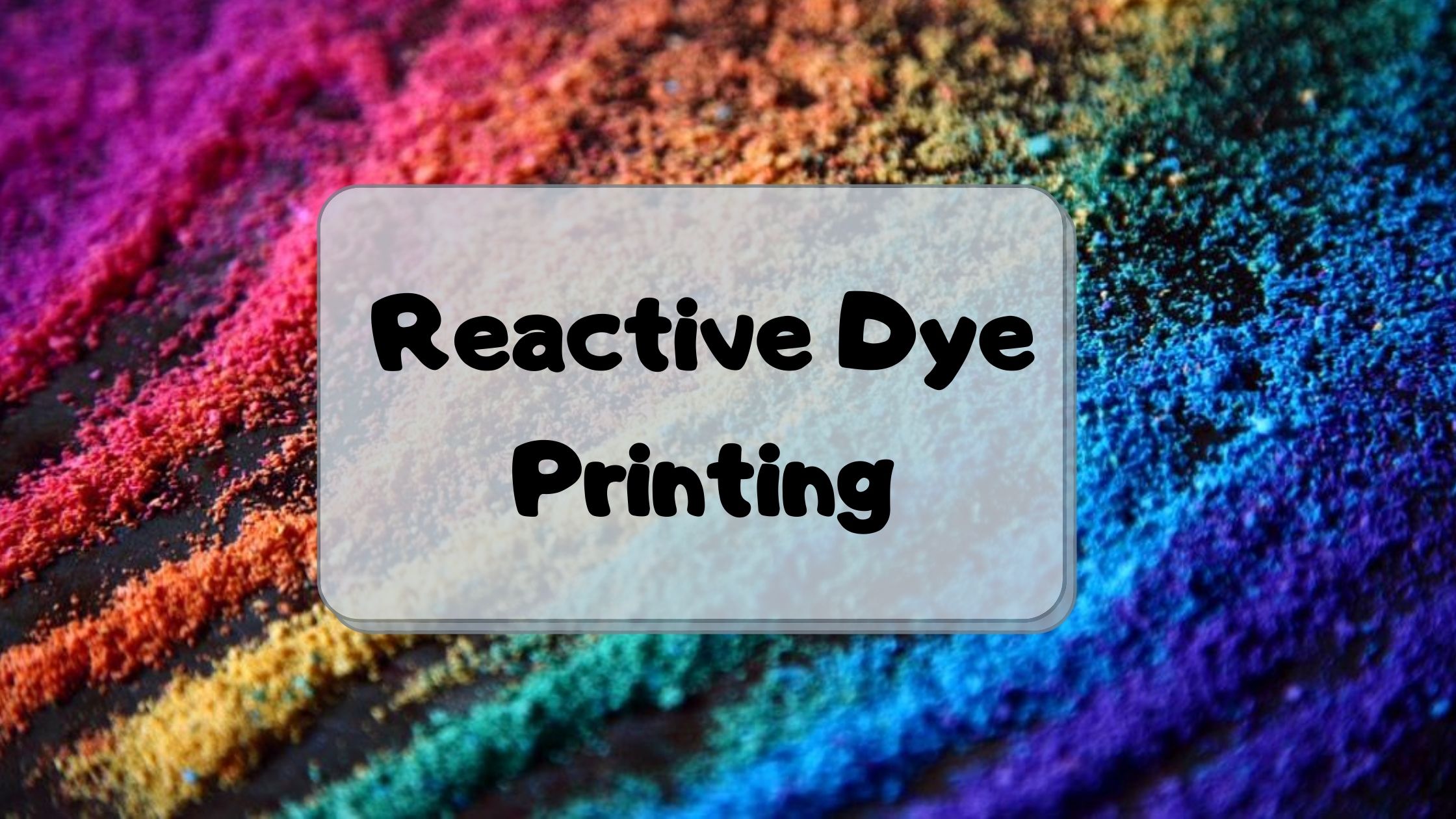For cellulosic material, reactive dye printing is an ideal process. But nowadays reactive dye is not only used in our conventional printing but also digital printing is carried out with reactive dye. In this article, we will discuss about reactive conventional printing, reactive digital printing and how to use reactive dye at home by yourself!
Reactive Dye Printing
Printing with reactive dye involves the penetration and fixation of dye molecules inside the fabric. This dye molecule fixed permanently with the fiber by creating covalent bond. Natural fibers like cotton, silk, wool, flax are printed with reactive dye perfectly.
Mechanism Behind Reactive Printing
Reactive printing involves printing of reactive dyes on the top of pre-treated fabric. Then the pint is steamed to fix the dyes with the fabric. The reactive group present in the reactive dye reacts with the fiber and creates covalent bond with the hydroxyl part of cellulose fiber. Steam helps to fix the dye inside the fiber.
After steaming, a washing off process is carried out to remove the unfixed dye from the fiber. It produces a sharp and brilliant printing effect on fabric.
What Will You Need to Print?
The following components are required to make a printing paste for reactive dye printing. Here’s they are:
- Reactive dye: Dye is colorant that is used to print the fabric
- Sequestering agent (Sodium hexa meta-phosphate): Sequestering agent is used to reduce the water hardness that is associate due to the presence of calcium or magnesium ion in water
- Urea: Urea is used as hygroscopic agent that helps to elevate dye solubility in water alongwith better penetration of dye inside the fabric. It also assists in increasing the brightness of print.
- Thickener (Na-alginate): Thickener is used to maintain the viscosity of print paste
- De-foaming agent: It will help to prevent the formation of foam in the print paste
- Soda ash: Soda ash is used to fix the dye molecules with the fiber because reactive dye fixation occurs in alkaline medium.
- Printing oil: Printing oil can help to pass the print paste efficiently through the fabric.
How to Reactive Print on Fabric
- Fabric is firstly pre-treated so that a good printing result can be achieved. Then prepare a printing paste combining all the ingredients.
- If you are using silk screen, then take print paste on the screen where the print design is developed. With the help of a squeeze print the design on top of the fabric with single or multiple stroke.
- If you are using ink jet printer, then after printing, a high pressure steamer is used to fix the print with the fabric. It is carried out at high temperature. Already, soda ash is used in the printing paste which helps in the fixation of it during steaming.
- Finally, a thorough wash is given to the fabric to remove the unfixed dyes or loosely attached dye molecules from the fabric. This process is a must to improve the fastness properties of reactive dye printing.
Should you Prefer Reactive Printing Over Other Methods
As a printer, there are different paths open to you. You can go for sublimation print or pigment print. Or you can choose reactive printing instead. You need to know about the basics of these printing methods.
Sublimation printing uses heat press and ink. But the ink must be volatile. Pigment print is great for the blended fabrics like cotton and polyester blends. This pigment deposits on the top of the fabric surface with the help of binders.
On the other hand, reactive dye printing is a good choice. The dye molecules present in the printing paste penetrates inside the fabric and form covalent bond with the fiber. Then rinsing is carried out and thus the unfixed dyes are removed. After that along lasting and prominent colored print pops out on the fabric.
Advantages of Reactive Printing
After the several washing process, the wet fastness and rubbing fastness has greatly improved in the fabric. Reactive dye provides a bright and sharp print on to the fabric. As it creates bond with fiber, a great printing comes out.
Drawbacks of Reactive Printing
- The main drawback of using reactive dye is dye hydrolysis. This can’t be stored as the dye molecules get hydrolysed. 40% dyes get hydrolysed.
- Another drawback is the usage of plenty of water. A huge liquor is used during dyeing. Again, for several washing process a lot of water is required which adds to extra cost.
Reactive Digital Printing
Nowadays, there are several printing approaches are introduced. Reactive printing, pigment printing, acid printing, disperse printing and sublimation transfer printing.
Which process is best for you, this is a case that depends on what type of product do you want? As a customer you really don’t need to worry about all these.
Just order to the manufacturer who will do the job for you, they will take your file and deliver you with the art work according to your choice.
What is The Process to Print the Fabric?
Reactive digital printing is a printing process where reactive dye is used to print pre-treated fabric through ink jet printing.
Then the fabrics are steamed in the steamer to fix the print. After steaming, the fabric is washed thoroughly. Sometimes three step washing is also done to remove the unfixed dye stuff and to improve the fastness property of the fabrics.
What Ink or Dyes are Used for Reactive Digital Printing and are They Safe?
Here Reactive dye is used and this dye is completely safe as having no harmful chemical group in their structure.
Is the Reactive Digital Printing Permanent?
Reactive printing process is considered as the most permanent process. In this process, a covalent bond is formed between dye and fiber.
Thus more strongly the dye is retained by the fiber. Often more or less color leaches from most of the fabrics. But this is less in case of reactive dye.
Running and fading occurs but the remaining color will be stable throughout the printing process.
Is This Digital Reactive Printing Process Eco-friendly?
Digital printing process is eco-friendly in regards to conventional textile printing. In conventional textile printing, too much chemicals are wasted.
They increases the effluent load to the environment. But in case of digital printing, the advanced technology drops the exact amount of ink needed. So the wastage is limited.
Already, we have known about reactive printing on fabric. So, let’s know some more. Do you want to dye your own material for yourself? No need to do so fancy, just follow these basic steps.
How to Use Reactive Dye?
Reactive dye is popularly used to dye cotton, linen, tencel, modal, bamboo fiber. To dye with reactive dye you must be careful.
Dye is added to the neutral bath then gradually the pH is increased. pH should be maintained properly otherwise uneven dyeing will take place.
Reactive dye-fiber bond is permanent as this creates a covalent bond with the fiber. By following the below process you can dye your fabric easily at home. Use this method for solid dyeing.
What will You Need for Reactive Dyeing?
Amount of salt, alkali or other chemical whatever we say, it is a function of the amount of water. The amount of dye is a function of load weight.
Dye: Use 1 tbsp dye for 1 lb of fabric or 1 kg dye for 100 kg fabrics depending on shades.
For 1 lb fabric,
Salt required = 3 cups
Water required= 3 gallons
Soda required= one-third cup
A step by step guide on the use of reactive dye. Dyeing is not that tough. Rather, it will be a fun for you if you are doing it correctly. Here’s how you can go:
Wash your fabric before dyeing
Pre-washing is a pre-requisite for dyeing. This is an important step which can’t be skipped at all. This can make a huge difference.
Wash your fabric using hot water and a quarter cup Synthrapol or any good quality detergent to remove all dirt, grease, soiling or hand marks also. Enzyme detergents can be used to wash the fabric.
If it is not possible then use soda ash along with it. Good alkali boiling is a necessary step while dyeing with cold brand reactive dye as it is very difficult to penetrate dyes into the fiber at such a lower temperature.
No need to heat press or use any sizing materials. Once your fabric is completely washed off, all the dirt will come out. This will make the fabric prepared for dyeing.
Prepare dye paste
Add some warm water to the dye powder and make a smooth paste of it with continuous stirring. Dye should be dissolved properly otherwise uneven dyeing will take place.
Then add a cup of warm water to dissolve the dye particles properly. Finally, add this to the warm water in dye pot and stir evenly. Some dyes like red, purple, black or brown can be difficult to dissolve.
To dissolve this dye Urea is the best option. 1 tbsp urea can be mixed with a cup of warm water. This will give a lump and freckle free smooth dye paste and make all the dye particles dissolved in it.
Dissolve the salt
Add the non-ionized salt with the warm water and dissolve it completely. Then add this to the dye pot. Glauber’s salt or regular salt can be added.
To reduce surface tension, a wetting agent can be added. Lisapol or Calsolene oil can be added to the dye bath. If you are using a turquoise color, be careful with it.
These dye particles are larger than other dye particles. They get darker and brighter while mixed with salt.
Add the fabric
Gently, stir the mixture for about 20 minutes. It should be done frequently. Then add your washed fabric to it. If the load is too heavy or you are too busy, then you can go for washing machine for agitation and proper mixing.
Add Soda ash
Add soda ash to the warm water to dissolve it properly then add the mixture to the dye pot slowly with continuous stirring. The soda ash solution should be mixed slowly.
This is highly recommended. If you add the whole mixture at one stroke, dark pathches or uneven shades will produce. If you use washing machine for agitation, while adding soda ash turn off the machine.
Add soda ash solution manually. Move the fabric to one side and add the soda solution on the other side and keep stirring. Then transfer them to the washing machine and continue agitation for the next 30 minutes.
Wash out excess dyestuff
Finally, rinse the fabric with running water to remove all the residual alkali, salt or hydrolysed dye particles. Then wash the fabric with warm water adding synthrapol or good quality detergent. If required, a second wash can be given for dark colors.
Wrapping It Up!
You can go for digital printing as this is an eco-friendly simple process. The demand for digitally printed fabric is increasing day by day. You can check: Properties and classification of Reactive dye

